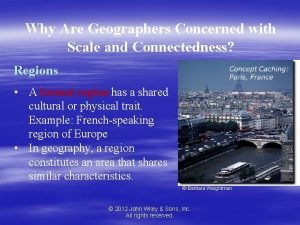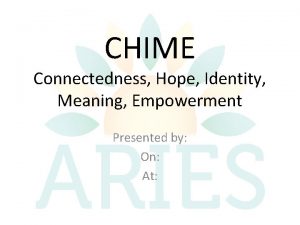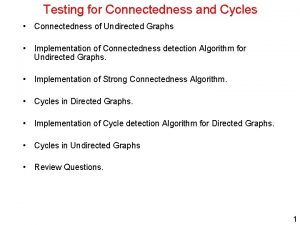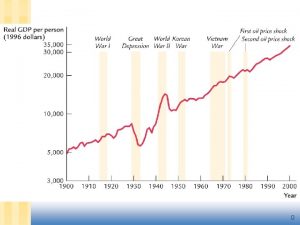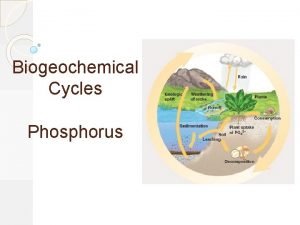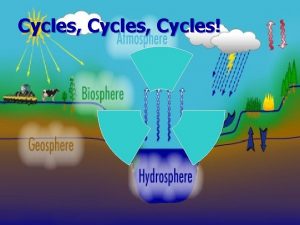Testing for Connectedness and Cycles Connectedness of an







- Slides: 7

Testing for Connectedness and Cycles • Connectedness of an Undirected Graph • Implementation of Connectedness detection Algorithm. • Implementation of Strong Connectedness Algorithm. • Cycles in a Directed Graph. • Implementation of a Cycle detection Algorithm. • Review Questions.

Connectedness of an Undirected Graph • An undirected graph G = (V, E) is connected if there is a path between every pair of vertices. • Although the figure below appears to be two graphs, it is actually a single graph. • Clearly, G is not connected. e. g. no path between A and D. • G consists of two unconnected parts, each of which is a connected sub-graph --- connected components. V = {A, B, C, D, E, F} E = {{A, B}, {A, C}, {B, C}, {D, E}, {E, F}}

Implementation of Connectedness Algorithm • A simple way to test for connectedness in an undirected graph is to use either depth-first or breadth-first traversal - Only if all the vertices are visited is the graph connected. The algorithm uses the following visitor: public class Counting. Visitor extends Abstract. Visitor { protected int count; public int get. Count(){ return count; } public void visit(Object obj) {count++; } } • Using the Counting. Visitor, the is. Connected method is implemented as follows: public boolean is. Connected() { Counting. Visitor visitor = new Counting. Visitor(); Iterator i = get. Vertices(); Vertex start = (Vertex) i. next(); breadth. First. Traversal(visitor, start); return visitor. get. Count() == number. Of. Vertices; }

Connectedness of a Directed Graph • A directed graph G = (V, E) is strongly connected if there is a directed path between every pair of vertices. • Is the directed graph below connected? – G is not strongly connected. No path between any of the vertices in {D, E, F} – However, G is weakly connected since the underlying undirected graph is connected. V = {A, B, C, D, E, F} E = {(A, B), (B, C), (C, A), (B, E), (D, E), (E, F), (F, D)

Implementation of Strong Connectedness Algorithm • A simple way to test for strong connectedness is to use |V| traversals - The graph is strongly connected if all the vertices are visited in each traversal. public boolean is. Strongly. Connected() { if (!this. Directed()) throw new Invalid. Operation. Exception( "Invalid for Undirected Graph"); Iterator it = get. Vertices(); while(it. has. Next()) { Counting. Visitor visitor = new Counting. Visitor(); breadth. First. Traversal(visitor, (Vertex) it. next()); if(visitor. get. Count() != number. Of. Vertices) return false; } return true; } • Implementation of weak connectedness is done in the Lab.

Cycles in a Directed Graph • An easy way to detect the presence of cycles in a directed graph is to attempt a topological order traversal. – This algorithm visits all the vertices of a directed graph if the graph has no cycles. • • In the following graph, after A is visited and removed, all the remaining vertices have in-degree of one. Thus, a topological order traversal cannot complete. This is because of the presence of the cycle { B, C, D, B}. public boolean is. Cyclic() { Counting. Visitor visitor = new Counting. Visitor(); topological. Order. Traversal(visitor); return visitor. get. Count() != number. Of. Vertices; }

Review Questions 1. Every tree is a directed, acyclic graph (DAG), but there exist DAGs that are not trees. a) How can we tell whether a given DAG is a tree? b) Devise an algorithm to test whether a given DAG is a tree. 2. Consider an acyclic, connected, undirected graph G that has n vertices. How many edges does G have? 3. In general, an undirected graph contains one or more connected components. a) Devise an algorithm that counts the number of connected components in a graph. b) Devise an algorithm that labels the vertices of a graph in such a way that all the vertices in a given connected component get the same label and vertices in different connected components get different labels. 4. Devise an algorithm that takes as input a graph, and a pair of vertices, v and w, and determines whether w is reachable from v.
